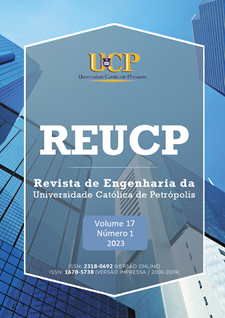EXPERIMENTAL STUDY OF GEOPOLYMER BINDER PRODUCED WITH METAKAOLIN AND GROUND GRANULATED BLAST FURNACE SLAG
Abstract
The need for alternative materials to replace Portland cement is a contemporary discussion. Those new and alternative materials must have a sustainable character and good durability to supply the demand of the civil construction sector and mitigate the environmental crises caused by the industry, such as the high emission rate of CO2. In this context, geopolymeric binders appear as materials produced by different solid precursors in contact with an alkaline activator, with zero CO2 emission and mechanical properties and durability compatible or superior to that of Portland cement. Thus, this study aimed to evaluate the geopolymeric binder obtained from the combination of metakaolin (MK) and ground granulated blast furnace slag (GGBFS) with three different molar concentrations of sodium hydroxide (8, 10, and 12 M) for the alkaline activator. XRD, XRF, and SEM analyses were conducted for solid precursors. Geopolymer pastes properties were evaluated in the fresh state regarding setting time and in the hardened state based on physical tests, average compressive strength, and fracture morphology. Results showed that the MK and the GGBFS have adequate reactivity and chemical composition for the geopolymer synthesis, with the presence of calcium in the GGBFS actively contributing to the reduction of the setting time and gain of mechanical resistance of the dosages. As for the hardened state, higher levels of water absorption are intrinsically related to a decrease in mechanical strength, with fracture analysis revealing the presence of pores and micropores that favor the propagation of cracks. Statistical analysis found that the interaction between the analyzed factors significantly influenced the properties of the materials, with 85.35% (R2 = 0.8535) of the model being able to explain the variation in compressive strength of geopolymers as a function of the factors used in the regression, limited to the chosen range of variables. The G40M12 formulation showed the highest compressive strength value (38.08 MPa) and the ideal synthesis parameters defined were the rotational frequency at 150 rpm, a partial replacement of MK by GGBFS of 40%, and the NaOH concentration of 12 mol/L. Finally, from the correlation of the evaluated characteristics, the developed geopolymeric binders showed technological potential as alternative and sustainable materials, with properties comparable to those of Portland cement
Downloads
Downloads
Published
Issue
Section
License
Autores que publicam nesta revista concordam com os seguintes termos:
I. O autor detém o copyright da sua contribuição, que abrange todos os objetos digitais que podem resultar na publicação eletrônica subsequente ou de distribuição. Após a aceitação da obra, o autor concede definitivamente à Editora o direito de primeira publicação da obra.
II. Ao enviar sua contribuição à REUCP, o autor assume e garante que:
1. Não foi previamente publicada nem está sendo avaliada por outra editora ou veículo de comunicação;
2. Não está pendente de revisão, exceto das eventualmente exigidas durante o processo editorial da REUCP;
3. As opiniões emitidas em sua obra são de sua inteira e exclusiva responsabilidade;
4. A obra não contém declaração falsa ou violação de trabalhos ou de direitos de terceiros;
5. A obra não contém difamação, invasão de privacidade ou assunto ilegal;
6. A revista poderá submeter seu original à avaliação de pessoas qualificadas e conservará sigilo e anonimato dos seus avaliadores/pareceristas;
7. A revista tem o direito de efetuar, em seu original, alterações de ordem normativa, ortográfica e gramatical, com vistas a manter o padrão culto da língua, respeitando, porém, o estilo autoral;
8. Concorda em indenizar a Editora UCP por violação de direito autoral ou qualquer outro processo movido por terceiros decorrente da publicação de seu trabalho (artigo ou resenha) na REUCP.
9. Concede à REUCP e à Editora UCP, bem como seus agentes, o direito não exclusivo e perpétua licença para publicar, arquivar e tornar acessível a obra, no todo ou em parte, em todas as formas de mídia agora ou no futuro conhecidas sob uma Licença Creative Commons 3.0 ou seu equivalente, que, para evitar dúvidas, permite que outros copiem, distribuam a obra sob as condições descritas no site da Creative Commons.
10. A pedido da Editora, concorda em fornecer prontamente à Editora UCP, às expensas do próprio autor, prova escrita das permissões, licenças e autorizações para uso de material de terceiros incluídos em sua contribuição (artigo ou resenha) à REUCP.
III. Ao enviar sua contribuição à REUCP, o autor concorda com os termos desta declaração.

